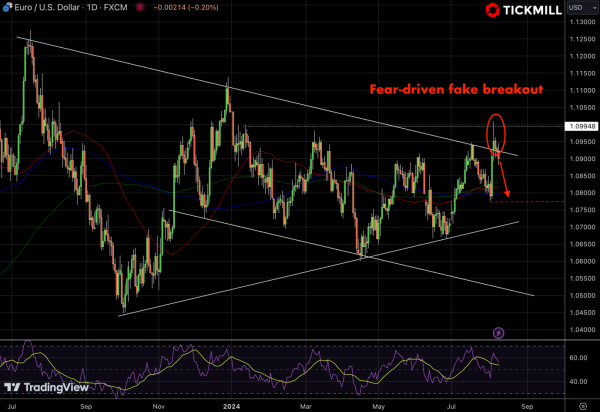EUR/USD Tumbles Below 1.0900 Amid US Dollar Resurgence
The EUR/USD pair has taken a hit, sliding below the 1.0900 mark during the American session. This dip comes as the US dollar shows renewed strength, buoyed by the latest US Initial Jobless Claims data, which suggests a labor market that's more resilient than previously anticipated. The number of individuals filing for unemployment benefits for the first time came in at 233K, beating both the market consensus of 240K and the prior week's 249K. This has provided the Greenback with the impetus to rally:

The US dollar's resurgence is not just a blip on the radar but a reflection of broader market sentiment. The DXY, which measures the USD against a basket of major currencies, has been on a recovery path, with traders closely eyeing key resistance levels. As it approaches the crucial 103.18 level, the question remains whether it can sustain this momentum and push towards the 104.00 mark, where the 200-day Simple Moving Average (SMA) lies.
The near-term outlook for the EUR/USD remains shrouded in uncertainty, largely due to the Federal Reserve’s monetary policy trajectory. The Fed's aggressive stance, driven by the need to counter potential economic headwinds, is keeping traders on edge. According to the interest rate futures, there’s a growing consensus among market participants that the Fed might slash interest rates by 50 basis points (bps) in September, with more than 100 bps of cuts anticipated by the year’s end. This aggressive rate-cutting narrative is fueled by concerns over job growth and a contracting manufacturing sector, both of which hint at a looming recession.
However, not everyone is convinced. Goldman Sachs has raised a cautionary flag, noting that despite rising market stress, their Financial Stress Index (FSI) does not indicate any severe disruptions that would necessitate emergency intervention by the Fed.
On the other side of the Atlantic, the Euro is feeling the heat as the market mood turns increasingly risk-averse. With fears of a global economic slowdown lingering, the Eurozone's currency is under pressure, especially with the European Central Bank adopting a cautious approach to monetary policy. Despite having initiated its rate-cutting cycle in June, the ECB has refrained from committing to a specific path, opting instead to keep rates unchanged in its July meeting. This cautious stance has led to speculation that the ECB might only cut rates twice more this year, as policymakers are banking on inflation easing back to the 2% target by 2025.
However, the absence of top-tier economic data from the Eurozone leaves the Euro vulnerable to shifts in market sentiment and speculative flows. The prospect of a prolonged period of restrictive monetary policy across major economies adds to the bearish outlook for the Euro, especially as global demand remains subdued.